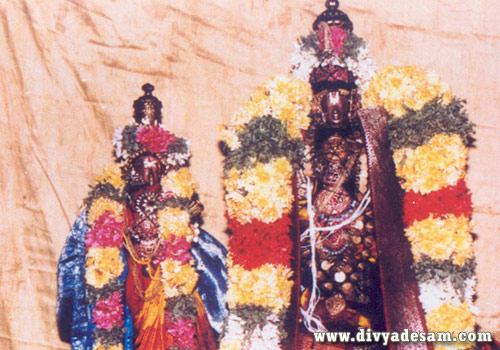SrI: SrImathE SatakOpAya nama: SrImathE rAmAnujAya nama: SrImath varavaramunayE nama:
periya thirumozhi >> Third Centum

After sending messages through messengers, the message which was given to the messengers went deep into AzhwAr’s heart, and AzhwAr started visualising those words; due to overwhelming experience, he thought that emperumAn was standing in front of him and speaking to him; emperumAn realised such special state of AzhwAr in his divine heart, being unable to bear AzhwAr’s suffering, he came and showed his face to AzhwAr and took her [AzhwAr in feminine mood] away; he sends AthivAhikars (those who can travel through space) to bring some of his devotees to him; he sends garudAzhwAr to bring some of his devotees to him; he himself comes for some as said in varAha charama SlOkam “nayAmi” (I will carry); in that manner, he arrived and covered parakAla nAyaki with the top portion of his aththavALam (upper cloth) and carried her with him; her divine mother who was guarding her from close, observed that she was missing from the cot; she then speaks about the nature of parakAla nAyaki, how she cannot survive without her daughter, her greatness which makes the other person feel for her in this way and her loss and calls out for her daughter.
What does it mean by emperumAn carrying parakAla nAyaki away? What is the inner meaning for that?
While she was having experience in his mind, it was so clear that it felt like external experience for her. varAha charama SlOkam is explained here:
- sthithE manasi … – The mind which constantly wanders, remains fixed, and the body which grows and contracts, remains in tact, without getting broken. [dhAthu … ] The three aspects namely vAtham, piththam and kapam remaining equal instead of one aspect increasing and the others decreasing and so on, and reach the firm state. In this manner, when the body is in such firm state and when sathva guNam is on the rise, whoever one may be, thinking about (1) one’s previous state of being a samsAri, (2) not having any principal in one’s own hand to eliminate this samsAram, (3) eliminating only by surrendering to bhagavAn and (4) bhagavAn having the Sakthi (ability) and prApthi (aptness) to help one cross over the samsAram, and submit one’s burden to him. When asked “Is this sufficient to attain the goal?” [Answer is] Yes. It is sufficient since just as bodily reactions lead to joy and sorrow for AthmA, I remain the AthmA for all to experience everything which occurs to each entity, and am free from birth based bewilderment which makes one forget about it after meditating upon me once. In this manner, for a person who is bound by prakruthi (matter), who meditates upon me once and subsequently roams around being engaged in worldly matters, and becomes unfit like wooden block or stone to even think about me, I remain thinking about him unlike him who thinks once and forgets subsequently.
- madhbhaktham – Did he surrender to someone who is difficult to worship considering he is not able to think when he has no such qualification? [No. bhagavAn is easy to worship]
- aham smarAmi – For those who desire aiSvaryam (wealth), Athma prApthi (self enjoyment) and for those who are engaged in bhakthi yOgam, anthima smruthi [thinking about bhagavAn in final moments] is required; since he has fully submitted his burden on me, I will think about him.
- nayAmi paramAm gathim – Thinking about him in this manner, I will carry him with my own hands. SlOka dhvayam (two SlOkams) are ISvaran’s whole wealth. Think about the nice conversation between periya nambi and emperumAnAr when a vaishNava (mARanERi nambi), who was a disciple of ALavandhAr, was suffering in his final days. When asked “Why does ‘madhbhaktham’ not indicate bhakthi yOgis? Who says that it should imply a prapanna?”. The response was “since SAsthram ordains anthima smruthi for bhakthi yOgis, this cannot be applied to them”.
- pAsuram 1 – kaLvankol
- pAsuram 2 – paNdivan
- pAsuram 3 – anjuvan
- pAsuram 4 – Edhavan
- pAsuram 5 – thAyenai
- pAsuram 6 – en thuNai
- pAsuram 7 – annaiyum
- pAsuram 8 – muRRilum
- pAsuram 9 – kAviyam
- pAsuram 10 – thAy manam
adiyen sarathy ramanuja dasan
archived in https://divyaprabandham.koyil.org
pramEyam (goal) – https://koyil.org
pramANam (scriptures) – http://granthams.koyil.org
pramAthA (preceptors) – http://acharyas.koyil.org
SrIvaishNava education/kids portal – http://pillai.koyil.org